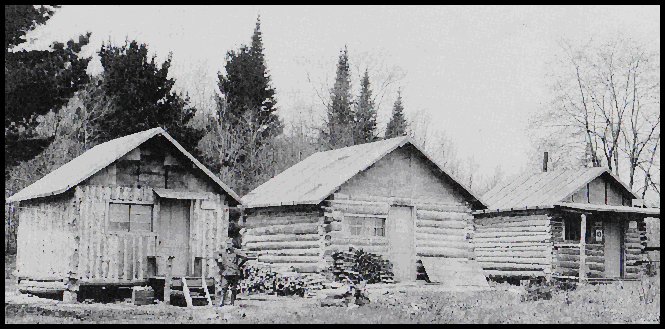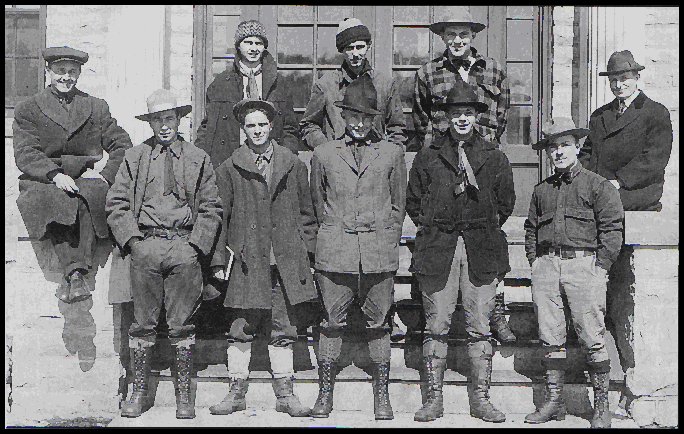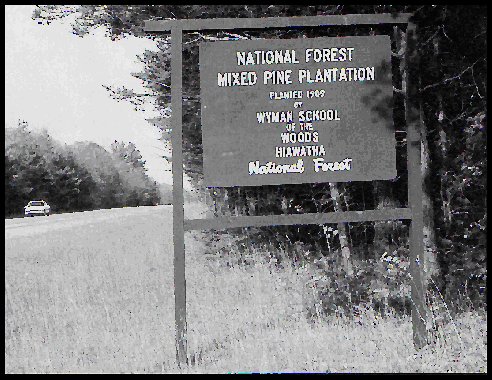
|
|
||||
Forestry Schools in
Upper Michigan; Then and Now . . .
By Louis J. Verme
| Wyman
School of the Woods
I first learned about the
"Biltmore stick," a simple device for scaling timber, as a freshman
forestry student at Michigan State College in 1946. At that time, of course,
it had little historical significance for me. Some years later I was employed
by the now Department of Natural Resources as a game biologist assigned
to the Cusino Wildlife Research Station at Shingleton in Michigan's Upper
Peninsula. It was here I became aware of the Wyman School of the Woods,
thanks to a prominent sign along Highway M-94, midway between Munising
and the hamlet of Forest Lake, marking the site of a mixed-pine plantation
established in 1909 inside what is now the Hiawatha National Forest. |
|
 |
Facilities for students attending the Wyman School of the Woods in Munising were primitive at best. Early on they lived in tents during a mandatory summer camp at nearby Perch Lake, although they later occupied log cabins built for course credit. (Mazzali family) |
|
In 1903, William Mather, CCI President, hired S. M. Higgins, a graduate of Cornell University, who thus became the first full-time corporate forester in Michigan. In order to prepare a comprehensive woods management plan, Higgins made Wyman his assistant for this demanding job. Wyman was soon transferred to Munising, where CCI had extensive timberlands and was given an assistant, Marcus Schaaf. (By coincidence, Schaaf was a fellow alumnus of the Biltmore School, had been employed by the Forest Service, and later became Chief of the Forestry Division for the Michigan Department of Conservation.) Wyman started a reforestation program for CCI by establishing a tree nursery at Coalwood, a railroad site a few miles southwest of Munising. According to The Munising News, in the spring of 1907 "Chief Forester Wyman had 75,000 white pine transplants ready to be set out," presumably on nearby corporate lands (a huge tree planting effort for that era). Reportedly, 19,000 white spruce seedlings were planted in the vicinity. He is said to also have planted a 10-acre "cherry orchard," presumably the native black cherry species. In addition to this work, Wyman advised CCI on logging operations in the vicinity. Wyman was instrumental in founding the Northern Forest Protective Association (NFPA), serving as its secretary. The members patrolled portions of the northern Lower Peninsula as well as the U.P. to spot and fight forest fires, which occurred with alarming regularity as the conifer forestlands were clearcut or high-graded, producing mile after mile of flammable resinous fuel. One historian noted that Wyman, without strong corporate backing, made "impressive gains for forestry through individual efforts. He not only continued the reforestation program near Munising, but with company permission began a forestry training program [school]," reportedly in 1908, using CCI land for teaching students, probably corporate employees. "This allowed him to accomplish more forest improvements than he otherwise could have.'' He left CCI employ when he became head of the NFPA. In July 1909, Thomas Wyman "officially organized" (i.e. formally opened) his legendary School of the Woods. It was incorporated in 1911, with William Mather being a principle stockholder, together with other merchants in the area. Students ranged in age from 17 to 21, and because of judicious advertising, came from almost every state in the union. They lived in private homes or at the city's YMCA. (The school's brochure noted that suitable room and board could be secured locally "at prices ranging from $5 per week upwards"). The curriculum consisted of a continuous 2-year program with 9 months of class work plus 3 months of hands-on field experience required each year. There were no vacation breaks except at Christmas. Classes were held whenever space was available; in the Munising High School, in church basements; vacant office of the area bank, unfinished attic of CCI's lumberyard building, and at its fish hatchery near the Anna River south of town. The academic scope of required courses was impressive even by today's standards. Students were taught basic botany, mathematics, zoology (including ornithology), soils, silviculture, logging methods and other bread-and-butter woods work. Specialists instructed them on such things as logging by steam, forest utilization, manufacture of wooden-ware and veneer, etc. Tuition cost $250 per year, excluding books, and each student was asked to buy field clothes, and other personal gear (even a .38 caliber pistol, for use unstated). To provide an opportunity for practical training, a summer tent camp was set up at Perch Lake, west of town. Shortly thereafter, however, "posh" log cabins were built there to accommodate the crew. In fact, students were given class credit for construction skills in this work. Some credit also was awarded for cooking ability at summer camp, in which "careful observations were made on the quality of cooking and cleanliness." A course in camp sanitation was given by a local physician, along with lectures on first aid, and "how to keep well." Initially Wyman was the sole instructor, but sometime later was joined by one R. R. Fenska from Yale (becoming a forestry professor at Syracuse University in 1926). To come full circle, his old mentor at Biltmore, Carl Schenck, came (was lured?) to teach at the Wyman School, evidently for just a few semesters, however. Not surprisingly, the famed professor's textbook dealing with principles of forest mensuration was used in pertinent classes. (He, after all, had invented the ubiquitous Biltmore stick for scaling timber.) In its heyday, the Wyman
School was considered among the top two ranger institutions in the country
(the other being at Wanakena, New York, established in 1912, and still
operating). There were never more than 30 pupils at Wyman at a time.
The Munising News reported that, as of February 1913, 22 students were
enrolled, up from 8 in November of 1911; the paper forecast that at that
rate "enrollment of the coming year would be 48", which obviously
didn't happen. Graduates were awarded a diploma in Forest Engineering
or in General Forestry, depending upon choice of major emphasis. However,
few of them graduated because these smart, well-trained technicians were
snapped up by private and public forestry agencies as soon as they showed
promise of becoming top notch workers. |
|
 |
The last class of Wyman School was in 1917. Founder Thomas Wyman is seated at right (of what presently is the Munising Community Building), and Professor Fenska sits on the opposite side. Longtime Munisingite William "Shorty" Mazzali (originally from The Bronx, New York) stands in front of Wyman. The person in the dark hat and coat standing next to him was Robert Williams, uncle of former governor and State Supreme Court Justice G. Mennen "Soapy" Williams. (Mazzali Family) |
|
Wyman left Munising a disillusioned,
if not brokenhearted, man. Just before he suddenly died in 1935 (age 54),
he had been appointed Forestry Conservation Engineer for the Tennessee
Valley Authority. For his illustrious pioneering effort, the Forest Service
dedicated the Wyman Tree Nursery at Manistique (now MDNR)
in his honor. Also, a Civilian Conservation Corps facility established
along the Coalwood Grade, near the site of his reforestation project,
was named for him (CCC Camp 671 Wyman). |
|
 A
rustic sign along highway M94, south of Munising, marks the location of
a conifer plantation established by Thomas Wyman and his forestry students.
An inconspicuous sign along the nearby Coalwood Grade commemorates the site
of CCC Camp 671 Wyman, named in honor of this famed forestry educator. A
rustic sign along highway M94, south of Munising, marks the location of
a conifer plantation established by Thomas Wyman and his forestry students.
An inconspicuous sign along the nearby Coalwood Grade commemorates the site
of CCC Camp 671 Wyman, named in honor of this famed forestry educator. |
|
![]() TOP
Press arrow to return to
the top of this page.
TOP
Press arrow to return to
the top of this page.

This website is maintained
by Bill Cook, Michigan State University Extension
Forester in the Upper Peninsula. Comments, questions,
and suggestions are gratefully accepted.
Last update of this page
was
16 November, 2007
This site is hosted by School of Forest Resources and Environmental Science at Michigan Technological University.